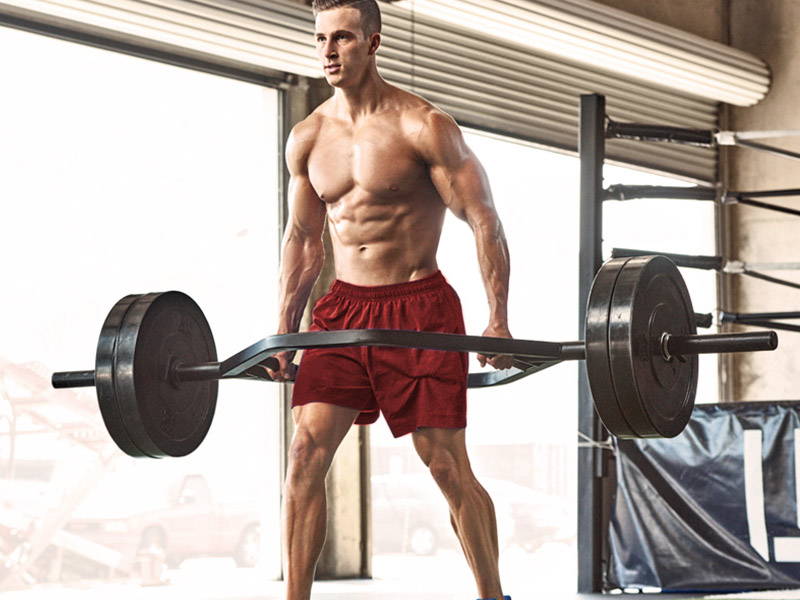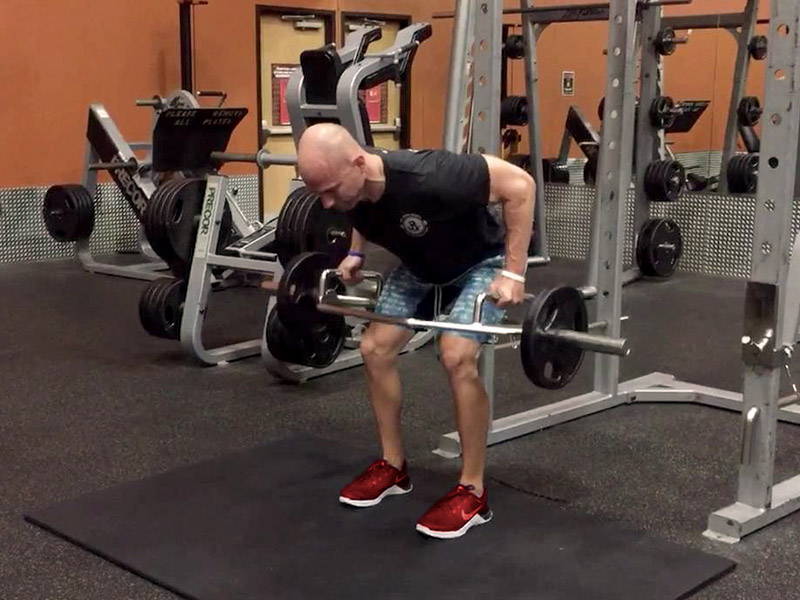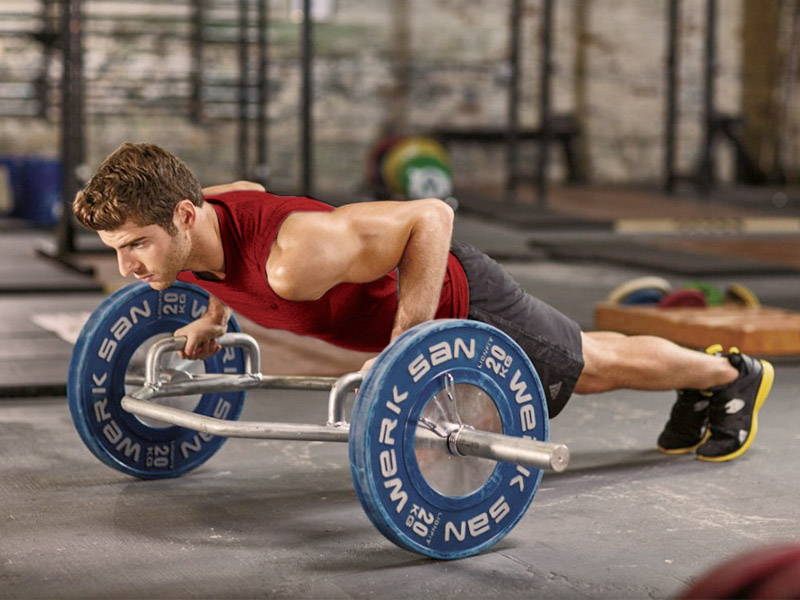
8 Best Trap Bar Workouts & Exercises
Key Takeaways
- Not just for shrugs and building your trap muscles, the hex bar can reduce the chance of shoulder and lower back injury in several exercises.
- You can use the trap bar in almost any exercise that includes a barbell. It’s also a great alternative to dumbbells and kettlebells when you max out on their weight limits.
- You can build both strength and muscle gains using the trap bar while getting an effective full-body workout.
- If you haven’t tried the trap bar before and are experiencing strength plateaus, especially in the Big 3 exercises, consider using it once per week to increase your RPMs.
The trap bar, also known as the hex bar, was invented in the 1980s by Al Gerard, a competitive lifter who thought his days doing the deadlift and squatting would soon be over.
Plagued with low back pain, he started to use heavy dumbbells to practice his lifts. From there, he developed the idea of a bar you could step into and have the weight equally distributed in front and behind.

After some trial and error, Gerard came up with a design that is now seen in gyms today. The trap bar is not just to do shrugs to build up the trapezius muscles, as some may think. No, the trap bar is an effective replacement for the barbell and even dumbbells in some applications.
Though not available during the Golden Era of bodybuilding, we could see some legends using the trap bar. Could you imagine seeing Arnold Schwarzenegger, Lou Ferrigno, or Tom Platz pulling serious weight inside the trap bar?
The trap bar is loaded on each end just like a traditional barbell. There are two separate handle sections, the low handle and then the high D-shaped handle. The handle preference comes down to the exercise and individual.
Trap Bar Benefits
There are benefits to using a trap bar instead of a standard barbell:
- One grip type to avoid potential muscle imbalance
- Less chance of spinal stress/injury
- High handles allow those with reduced hip range of motion (ROM) to still lift
- Easier to learn how to deadlift properly
- No chance of hyper extending during the lockout phase
- Can improve power and performance for athletes
The trap bar also comes in an open version where one side is eliminated. The open trap bar allows for single-leg variations of exercises and can make loaded carries easier.
Today, we will discuss some of the best exercises using the trap bar in place of dumbbells and the barbell. If you have access to a trap bar, consider using it for the exercises showcased today for a killer workout.
1. Trap Bar Suitcase Carry
If you’ve maxed out dumbbell or kettlebell weights and you find the barbell hard to balance, consider the trap bar. You should be able to easily balance the bar compared to a barbell when performing the suitcase carry.
The suitcase carry is an effective full-body workout, especially for improving core stability and grip strength. Complete this exercise and then take notice when you’re able to push through deadlift plateaus like never before.

How to do it:
- Load a lightweight to get started on either end of the bar. Once you get used to carrying the trap bar, you can increase the weight.
- Place the trap bar on its side and grab the bar with one hand, as if you’re grabbing a suitcase. Engage your core and lift the trap bar off the ground.
- Using an even pace, walk from one end of the room to the next. Depending on the length of the room, turn and walk back or switch hands and then turn to walk back.
Carry the bar for at least 30 seconds, up to 60, per arm per set. Do this for three sets. Take up to a 60-second rest between sets if needed.
2. Trap Bar Bent-Over Row
Reduce stress on the lower back and get a greater range of motion using the trap bar for the bent-over row. This will allow you to focus more on building the upper back and latissimus dorsi (lats) muscles.

How to do it:
- Load up the trap bar and stand in the center. Grab the high handles, keep your knees slightly bent, core, back, and lats engaged.
- Push your glutes back and keep your chest up.
- Lift the bar up to do the row and squeeze your shoulder blades together at the top as you hold for a second.
- Then take the bar back down to the ground to complete the rep.
Complete 8 – 12 reps for three sets. Take up to 60-seconds to rest between sets as needed.
3. Trap Bar Squat
You can use a trap bar the same as a barbell to complete a weighted squat. This trap bar exercise will work all the major muscle groups.
The high handle configuration provides those with limited shoulder mobility a chance to perform this exercise without risking further injury. If you need a cushion between your upper back and the bar, consider rolling a towel around the bar.

How to do it:
- Place the trap bar in a squat rack and load the bar.
- Step under the trap bar with the high handles facing down and grab those handles in each hand.
- Step back from the rack and then get into position to perform the squat.
Variations: We have featured the squat several times with different variations. If it can be done with a barbell, it can be done with a trap bar. Check out Golden Era Tom “The Quadfather” Platz teaching squat techniques during a Master Class.
4. Trap Bar Floor Press
Instead of using a barbell or dumbbells, try the trap bar to do the floor press. The triceps, shoulders, and pecs will get a great workout without risk of shoulder rotation.

How to do it:
- Set the trap bar up on a low post on the squat rack. Lay down underneath the rack so you’re able to grab the weight laying down.
- You should be flat on your back with your knees up and your feet flat on the floor.
- Start out using the low handles of the trap bar; the high handles will increase the challenge.
- Lift the bar out of the rack and begin to press the bar up, pause for a second before you bring it down to your chest and repeat.
Do 6 – 8 reps for three sets if you are focused on muscle growth. If you want to build strength, then do 4 – 6 reps and increase the sets to five. Take up to 60-seconds to rest if needed between each set.
5. Trap Bar Romanian Deadlift
The trap bar RDL is another exercise that can eliminate strain on the lower back when replacing the barbell or dumbbells. Instead, allow the traps, posterior chain, hamstrings, and glutes to do their job and achieve muscle growth.
For athletes, it may be best to replace the barbell with the hex bar for all deadlift variations. A study in the Journal of Strength and Conditioning Research found its superior for maximum velocity, power, and force.
How to do it:
- If you don’t want to start with a regular deadlift, start with the trap bar in a rack near your hips.
- Step into the center of the hex bar and grab it by the high handles. You want a slight bend to the knee, with the back straight and the chest up while moving through the exercise.
- Keep your glutes and core engaged and use your hamstrings to help with the weight.
- Hinge your hips back as you slowly lower the bar down towards your shins.
- Stop right before the weight touches the ground. Now, move the bar back up to your hips, activating your glutes to help bring the weight up.
As we learned when comparing the stiff-legged deadlift to the Romanian, low reps with heavier weights work best. Complete 4 – 6 reps for 3 – 4 sets.
If you’re a beginner, start out with two sets and work your way up to four. Also, make sure you have perfect form in the deadlift before you try this advanced version. We give you detailed instructions on deadlift form here, which can also be done with the trap bar.
6. Trap Bar Overhead/Shoulder Press
Looking for a more defined upper body with chiseled deltoid heads to match? You can do the overhead press using a hex bar to allow for increased load without further risk of shoulder injury.
For details on form to make the overhead press work for you, check out our guide here.

How to do it:
- Add weights to the trap bar on a rack, with the bar between trap and head height. Stand in the middle of the trap bar with your feet shoulder-width apart and remove it from the rack.
- Use the low handles for this exercise. Begin by pressing the bar until your arms are straight but elbows remain unlocked.
- Pause for a second at the top before you lower the bar back down to complete the rep.
Complete 6 – 8 reps for three to four sets, depending on your goals (hypertrophy or strength). Rest up to 60-seconds as needed between each set.
7. Trap Bar Farmers Walk
Get one of the best full-body workouts from this trap bar exercise. The trap bar will allow you to carry more weight than dumbbells or kettlebells, plus you’ll build more grip strength.

How to do it:
- Load the trap bar and step into the center, grabbing it by the high handles.
- Keep your chest up and maintain tension in your arms and core as you slowly walk forward.
- Depending on the space you’re in, keep moving forward or turn around and keep walking until time runs out.
Walk for 30 – 60 seconds to complete one set and do three to four sets. Take as much as 60-seconds to rest between sets if needed.
8. Trap Bar Push-Up
This weight-optional variation of the standard push-up can help you get a greater negative stretch to build your chest and biceps. Adding weight will increase the challenge as you’ll also have to maintain balance while doing the push-up.
If you need instructions on proper form to complete a solid push-up, check this out first.

How to do it:
- Lay the trap bar down on the ground with the high handles up. If you’re adding weights, then you’ll want the high handles facing up.
- Grab the high handles and get into position to start the push-up.
- As you move down, go slightly negative past the handles to get a deeper stretch on the muscles.
- Pause for a second before you push yourself back up to the starting position.
Complete 6 – 8 reps and 3 – 4 sets. Take 45 – 60 seconds to rest between sets as needed.
Wrapping Up
The trap bar is not just a great way to increase the size of your trap muscles. It can also be an effective way to reduce strain on your lower back and shoulders.
You can also get more gains if you’ve maxed out using dumbbells or kettlebells on certain exercises. The basic rule is if you can use a barbell, then you can replace it with the trap bar.
If you’re looking to build your muscle definition, go for higher reps and lower sets. However, if you’re looking for strength, lower reps with a heavier weight and fewer sets will do the trick.

To guarantee you meet your goals, the size & strength stack can help you get there. It includes our two-stage pre-workout, 3-in-1 muscle builder, and a testosterone builder. This stack will motivate you through every second of the workout and aid you through recovery.
Do you use the trap bar regularly? What have you noticed about its benefits over using other weight lifting equipment? Do you have an exercise you want to share that we didn’t list here? Let us know in the comments below.











